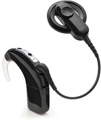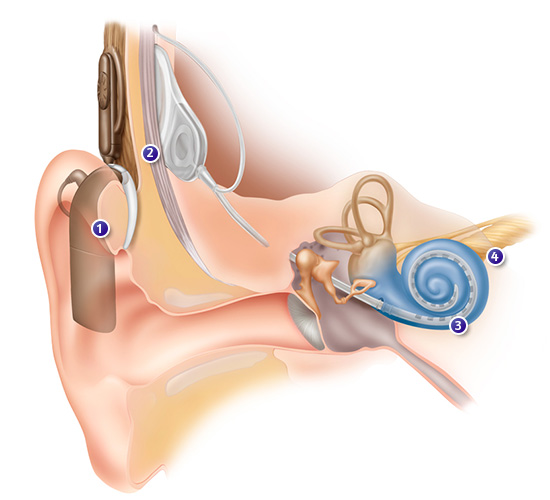What is a cochlear implant?
A cochlear implant is an electronic device that allows people with profound deafness to access sound more effectively. It consists of an internal part and external part.

The internal part is inserted under the skin behind the ear during surgery under general anesthetic.
The external part consists of a processor connected to an antenna, which has a magnet that keeps it in place next to the internal part so that contact can be maintained.
The internal part and external part are essential to the implant’s operation.
How a cochlear implant works

This photo courtesy of Cochlear™ Americas, © 2009 Cochlear Americas.
- The microphone captures sounds from the environment. The processor then analyses the sounds.
- The encoded sounds are transmitted to the internal part. They are then transformed into electric impulses.
- The electric impulses are transmitted to the electrodes.
- The electrodes stimulate the auditory nerve, which sends the information to the brain.
How good are the results with an implant?
The results vary greatly from one person to another, and an implant can never generate normal hearing. It is impossible to predict how you will hear. Although we can fine tune how your implant is programmed, we have no control over how your auditory nerve, central auditory pathway, or auditory cortical region work, and these all play a key role in the quality of the sound that you perceive.
Generally, when we determine that a hearing impaired person is a candidate to receive a cochlear implant, it’s because the odds are good that the person will hear better with the implant.
The information flow from a cochlear implant complements the visual information received from lipreading, and this helps achieve better communication. Everyone with a cochlear implant can hear sounds and distinguish between sounds that are short or long, loud or quiet.
Most can also distinguish between high- and low-pitched sounds and recognize some everyday sounds in the environment, such as a doorbell, car horn, or ringing telephone. Most can also recognize a word or phrase from among a limited selection of words or phrases.
It’s impossible to predict how someone will perceive speech after receiving a cochlear implant. Most patients can hear speech but it generally takes some time for them to start to understand sounds (especially children). With an effective follow-up program, a period of rehabilitation, and full-time use of the processor, patients are gradually able to understand speech. If you wear a conventional hearing aid on your other ear, we may recommend that you not wear it for a certain period of time until you have adjusted to your implant.
Some people are able to understand words or phrases without reading lips and are able to use a telephone for simple conversations with people they know.
Finally, some people are able to understand almost everything without reading lips, but this occurs more rarely.
Listening to music with a cochlear implant is not generally pleasant. Implants are designed to make it easier to understand speech, and the sound coding strategies used are tailored to processing speech. Some people do, however, get report getting a certain enjoyment from listening to music.
When is an implant not recommended?
If another option is available, such as conventional hearing aids, a cochlear implant is not recommended. If your hearing aids are not adjusted to your level of deafness, we may recommend that you see your audiologist / hearing aid practitioner for adjustments or to purchase new units. If you can perceive speech well using conventional hearing aids, these are a better option for you than cochlear implants.
If you have been profoundly deaf for quite a while, cochlear implants are not recommended. If your auditory nerve has never been stimulated or has not been stimulated for a very long time, it may not be able to correctly transmit sound information to the brain.
A cochlear implant will have no effect if the problem is found elsewhere than the inner ear (e.g. auditory nerve). Also, if your cochlea is damaged and cannot take an electrode, a cochlear implant is not recommended.
Patients must be in good enough health to handle anesthesia and recover from the procedure. They must also be able to attend the follow-up program (programming and rehabilitation) after the operation. The list of necessary follow-up is found further on in this document.
It is essential for patients and families to have realistic expectations about cochlear implants.
Finally, support from family and friends is key to success for someone receiving a cochlear implant.


